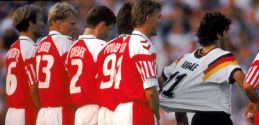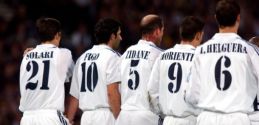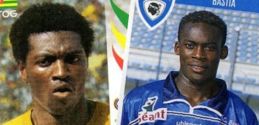Hidden Maradona’s: Argentina’s embarrassment of riches
Maradona. Messi. Riquelme. Ortega. Aimar. Pastore.
Argentina produces a quite unbelievable number of high quality playmakers. In that country, the role is called the “enganche”, which literally means “the hook” between midfield and attack. Argentine football identifies slightly different roles with different shirt numbers to the European norm (an Argentine number 5 is a defensive midfielder, and a number 8 an all-round midfielder, for example) but the number 10 is so closely identified with the playmaker role that the position is also casually referred to as a “10”. It’s a controversial role, too. Some don’t believe in the mystique of the 10. Former Argentina coach and all-round mad genius Marcelo Bielsa, for instance, favours an 8 in the 10 position, seeing even a player as sublimely talented as Juan Roman Riquelme as a luxury a team cannot afford. Current coach Alex Sabella resisted the skills of Pastore in his first games in charge, again preferring a more prosaic 8 in the form of Metalist Kharkiv’s Jose Sosa (though he did play Messi, who rarely plays as an out-and-out playmaker).
But the 10 is a part of Argentinean football heritage, and the assembly Line keeps on pumping out skilful little playmakers. So many so, in fact, that Argentinean football cannot contain them all. They play all across the Americas, in Europe and Asia, for legendary clubs and small ones, in glamorous spots and backwaters, winning acclaim and trophies or just making a living. Some are famous: the Aimar/Riquelme generation also included lesser but not inconsiderable talents like Montenegro, D’Allessandro, Romagnoli, Insua and Delgado, all of whom have played in Europe and would probably have won many caps each if not for the talent ahead of them. This is an old, old problem for Argentine playmakers. Ricardo Bochini is a legend who drove his club Independiente to a series of trophies, including four Copa Libertadores, between 1973 and 1984, with his beautifully precise passing and amazing ability to spot a through-ball. He, alongside the similarly talented Claudio Borghi, barely played for his country. Why not? Well, the existence of a certain Diego Armando Maradona is why not. In the years after Maradona’s retirement, Ortega and Marcello Gallardo competed consistently against one another for the role of first choice 10. Ortega has more caps, and Gallardo arguably never quite fulfilled his immense talent.
I suspect that Messi and Pastore’s combined talents may just mean that the likes of Maxi Moralez, Sebastian Blanco and even Erik Lamela may just suffer the same fate.
Beneath that level there are a number of brilliant Argentine playmakers plying their trade all over the World, especially in the other countries of Latin America. Here are a few you may not have heard of but should certainly check out:
Jonathan Fabbro
(Cerro Porteno, PAR)Buenos Aires club Argentinos Juniors is legendary for the regularity with which its youth system produces great players. Even the giants of the Argentinean game, the big five of Boca Juniors, River Plate, Racing Club, Independiente and San Lorenzo cannot really compete with the level of talent produced by a club nicknamed “El Semillero” or “seed garden” (a looser translation would be “nursery”). Maradona, Riquelme and Fernando Redondo - each arguably in a list of the five or ten best Argentine players of the last few decades - all came through at Argentinos, alongside the likes of Borghi, Esteban Cambiasso, Fabricio Coloccini, Juan Pablo Sorin and Sergio Batista.
Fabbro is another, far less celebrated graduate of El Semillero. An old-fashioned Argentine playmaker, he is almost a perfect stereotype in how he fills all of the criteria of the breed; long-haired, whip thin, and incredibly inconsistent. Capable of flashes of absolute genius, he is also liable to disappear utterly during games, or worse, play almost aggressively badly. He possesses the arrogance necessary in any great 10, the self-belief that empowers players to try the unlikely pass, the outrageous flick, the hopeless dribble. This means that on bad days, days when he’s not quite on his game, he repeatedly gives the ball away, and spends a lot of time with his hands on his hips, shaking his head in frustration.
He has long been a footballing nomad, only settling down in the last few years. He never made the first team at Argentinos and transferred to Mallorca in 2002, again never playing, before returning home for a short stint at Boca Juniors the same year. He first made a real impression in Colombia at Once Caldas, after a 2004 transfer. Based in Manizales, Once Caldas were surprise winners of the Colombian title in 2003 and even more surprisingly they won the Libertadores in 2004, with Fabbro in the side, although he typically started as substitute. That team played a really cagey, counter-attacking game, and beat Boca on penalties in the final. I first really became aware of Fabbro in the Intercontinental Cup final where they lost to Porto, again on penalties. Fabbro started that game and was the classiest player on the pitch, cleverly using the ball every time he had it, but memorably missing the penalty which would have handed his side the cup.
Soon after he moved to Dorados de Sinaloa in Mexico for a season and in 2006 had short spells at two big clubs; Brazil’s Athletico Miniero and Universidad Catolica in Chile.
He finally found a home in Paraguay when he joined Guarani of Asuncion in 2007, becoming a talismanic presence over three seasons there and winning the clubs first title in 26 years in 2010. Following that he moved to rivals Cerro Porteno, playing a key role in their storming run to the semi-finals of the Libertadores last season.
His character remains the same, a beguiling mixture of petulance and genius. He has obtained Paraguayan citizenship, hoping for a call-up to the Paraguay national side. Since their biggest flaw is a lack of creativity, Fabbro is certainly worth a try. On his day he is a proven match-winning talent and a great player to watch.
David Ramirez
(Velez Sarsfield, ARG)Argentina is an immensely centralised country, and this is magnified in the nations football, where all of the big clubs come from football-crazy Buenos Aires, together with the big two from Rosario. So when a player emerges at a provincial club, no matter how well he plays or how successful his club is, there is the expectation that he come to the capital and prove himself at a big team. This expectation was heightened in the case of David “el Mago” Ramirez (above, left) by the fact that his first truly notable season in Argentina didn’t arrive until he was 29 and at unfashionable little Godoy Cruz of the Mendoza Provice, near the Chilean Border. He had been knocking about Argentinean football for a decade or so, playing in the lower divisions and the Primera, including spells at the famous Ferro Carril Oeste and time outside Buenos Aires with Olimpo and Gimnasia y Egrima de Jujuy, as well as a previous season at Godoy Cruz. He also played in the Spanish Second Division during a six month loan spell at SD Ponferradina in 2006 and had a relatively successful season in Chile with Unión Española in 2009.
But it was following his 2010 return to Godoy Cruz that Ramirez suddenly emerged as a serious talent. A beautiful combination of elegant movement and physical strength, Ramirez offered exactly what an enganche should; he scored goals and he set them up. Give him the ball around the opposition area and he would inevitably slip a team-mate through on goal, and he had a knack of arriving at just the right time to finish off moves.
Riquelme, injured for most of that season and probably watching a lot of football as a result, called him the best player in Argentina.
His play - he scored an impressive ten goals in 32 appearances from midfield - galvanised a strong Godoy Cruz squad who challenged for the title, playing some lovely football, and managed to qualify for the Libertadores for the first time in their history with a third place finish.
But Buenos Aires had noticed Ramirez, and Velez Sarsfield bought him for approximately US$3 million in January 2011. Velez already had an exceptional playmaker in the form of little Maxi Moralez, and back-up in Ricky Alvarez, and so Ramirez started mainly on the bench last season. But he still made an eye-catching contribution, scoring a stunner on his Libertadores debut against Caracas and ending that season - in which Velez won the Argentine title and were unlucky to exit the Libertadores to Penarol at the semi-final stage - as top scorer, with eight goals in 14 games.
This season, Velez have sold Moralez and Alvarez, and so Ramirez has the 10 shirt and, alongside Augusto Fernandez, much of the creative responsibility for a side who have mounted a strong late run for the championship after a shaky start left them way off the pace set by a revitalised Boca. They are also on course for the final of the Copa Sudamerica (the South American equivalent of the Europa League) where neutrals will be hoping for a match-up with the exhilarating Universidad de Chile side currently wowing South American fans with their counter-attacking power game.
Ramirez, now 30, has left it late to be an overnight success, and he admits that chronic shyness may be the reason for this. If he were Paraguayan, Bolivian or Peruvian, then based on his current form, he would be a fixture in their national side. But he is Argentinean and content to win some trophies and plaudits late in his career.
Aside from all that, any player in South America nicknamed “el Mago” (the wizard) has to be worth a look. The other prominent wizard is the little Chilean genius Jorge Valdivia, currently at Palmeiras, and what a player he is..!
Walter Montillo
(Cruzeiro, BRA)Given the ferocity of the football rivalry between the two countries, it is somewhat startling how important Argentinean playmakers have proven to the Brazilian Championship over the last few years. Most notable are the examples of Dario Conca, who was the lynchpin of the championship-winning Fluminense side who won the 2010 tournament before a big money (he gets US$10 million annually) move to Guangzhou Evergrande in China, and the much-travelled former “new Maradona” Andreas D’Allessandro, who is a key player for Internacional of Porto Allegre, with whom he’s won both the Libertadores and the Copa Sudamerica since 2008. Add to those two Dario Bottinelli at Flamengo, Marcelo Cañete at Sao Paolo and Manuel Lanzini and Alejandro Martinuccio, both seeking to replace Conca at Fluminense, and you have a fully-fledged, impossible-to-ignore trend.
Walter Montillo is another, and earlier this year when his club Cruzeiro were playing scintillating attacking football revolving around his quick feet and beating the likes of then Argentine and South American Champions Estudiantes 5-0, it looked like he might be the best of the lot.
He began at San Lorenzo, had four years there in which he was in and out of the first team but never played spectacularly, before a loan to Monarcos Morelia in Mexico for a year in 2006 and 2007 gave him more playing time. A return to San Lorenzo coincided with a championship triumph, but Montillo played little and he accepted a move to Universidad de Chile in 2008, for a then Chilean record fee of $1 Million.
Playing as the first choice playmaker at a big club for the first time, Montillo thrived. He has all the attributes of the classic Argentine 10; he’s short (5ft7) and stocky, his vision in the final third is matched by his ability to pick a pass, he can dribble through opponents at speed, and he has an eye for the spectacular goal.
In his two years at La U, he won a title, scored 15 goals in 62 games, and impressed many observers with his performances in the Libertadores.
That was how Brazilian clubs spotted him, with Flamengo making an offer after he scored against and generally terrorised them in a 2-1 win in Santiago. He signed for Cruzeiro in July 2010 and though his form dipped, alongside that of the entire team, at the start of this season, he has generally been terrific, scoring 19 goals in 51 games, creating many more and winning the Trofeu Armando Nogueira as best player in the Brasileiro last year.
He was even called up for Sabella’s “domestic” Argentina squad for the second of two Copa Roca games against Brazil in September, his first cap. He didn’t acquit himself as well as he might have done, but for a player who never really made it in Argentina, to start as an attacking midfielder in a Superclasico against Brazil was no small achievement.
Martin Rolle
(Olimpo, ARG)Prevailing wisdom currently suggests that changes in the physicality of the Argentinean game have affected the physical profile of its players. Athletes are generally bigger, stronger and faster than ever before, meaning that the classic pint-sized enganche of yore - the midget street urchin with feet quicker than the eye can follow and an ability to see a space in the game before anybody else - is less prevalent. The modern playmaker is more in the mould of Riquelme; tall and strong. Colombian Gio Moreno of Racing Club, Erik Lamela, now of Roma but recently a star at River Plate, and Javier Pastore’s success at Huracan all appear to bear this out. But the little men still exist, and when they play, they tend to excel. Maxi Moralez was arguably the best player in Argentina in each of his seasons at Velez, and Martin Rolle was one of the biggest stars of last season for Olimpo.
Rolle is 5ft4, but his personality on the pitch more than compensates for his stature. To watch Olimpo at the moment is to marvel at the way all their attacking play goes through him, as he ceaselessly searches for space, takes the ball and gives it, erupts into little dribbles at pace, sets up one-twos, and slyly aims through-balls at his strikers.
After his superb performances last season, many expected Olimpo to lose him to a big Buenos Aires club, but so far the Bahia Blanca club have retained his services.
But then the glamour and pressure of the capital may not suit Rolle. He emerged at Guillermo Brown, a small club from the coastal town of Puerto Madryn in Patagonia who play in the Torneo Argentina B, a regional league composed of teams from the interior. After two years there, in 2003, he moved to the big club in his province, C.A.I. from Comodoro Rivadavia, who play in the Primera B, the Argentine second division (currently home to giants River Plate, Huracan and Rosario Central). Olimpo were in the same division when they bought him in 2009 but were promoted as champions that year and have stayed up, surprising many, ever since. Rolle has been central to their success, the fulcrum around which their passing game revolves, scoring an impressive 25 goals in 74 games for the club, outshining Riquelme in a 2-0 win over Boca Juniors last season, and generally suggesting that Olimpo will be lucky to hold onto him for much longer.
The only question is which club will make a move for him.
Pablo Vitti
(Universitario de Deportes, PER)The Under-20 Argentina side that won the 2005 World Youth Championship in Holland was filled with players who have gone on to have good careers at big clubs. Players like Messi, Aguero, Gago, Zabaleta, Biglia and Garay, all stars for big European clubs and full internationals. Of course there were others who didn’t develop along the same lines, who settled for careers at smaller clubs in Argentina and Europe, and those who were never good enough in the first place. Then there’s somebody like Pablo Vitti.
At the time he seemed like the chosen one. He started upfront for that Argentina side in the first game of the tournament, against the USA. Messi and Aguero,the youngest members of the squad, were substitutes. But Argentina disastrously lost the game 1-0 and Vitti didn’t play as well as he had done for youth teams at other levels, or as well as he had been doing for his club, Rosario Central. He was dropped to the bench for the next game, Messi and Aguero came in, and their success meant that he played only a bit part for the remainder of the tournament, not featuring at all in the semis or the final. While Messi was the tournament’s top scorer and was voted best player - no surprises there - Vitti, who had looked a future star before he tournament, came away from it disappointed and with a damaged reputation.
That was where it all went wrong for him. In 2006 he left Rosario - where he had been given the 10 shirt and made 74 appearances over three years, scoring 13 goals -for a short, unsuccessful spell at Banfield, who in turn sold him to Independiente, where he barely played at all. They loaned him out to first Chornomorets Odessa in the Ukraine in 2008, and then Toronto FC in the MLS in 2009. There are other second-tier Argentines playing in that league, but Vitti had given every sign, as a youngster, that he was capable of much more, and when he returned to Independiente and was finally sold to Universidad San Martin of Peru, it suggested he was settling for an easy career in a slightly weaker South American League.
But Vitti excelled in Peru, scoring 14 goals in 36 games in 2010, by common consent the best footballer in the country last year. This earned him a move to Universitario, one of Peru’s big two alongside Allianza, where, as part of an exciting young team, his fine form has continued against a backdrop of financial uncertainty, crowd violence and comedic organisational chaos. Interestingly, his position and shirt at San Martin have been taken by one Carlos Marinelli, another journeyman playmaker and former “New Maradona” and, once upon a time, a catastrophic flop at Middlesbrough.
Lucas Lobos
(Tigres UANL, MEX)Mexico is a country and a football league kind to Argentines. The Mexican economy means that the league is strong and, compared to Argentina, relatively wealthy, without the cultural and language gap that even Brazil presents to the Argentine player seeking to earn a living abroad. The level of play is similar to that in Argentina, making it an ideal destination for players who have failed in or are not quite good enough for Europe but are too strong for the Argentine league. The most high-profile over the last few years are probably Cesar Delgado and Christian Gimenez, both of whom have dazzled at Cruz Azul, but there are others.
Lucas Lobos is one such player. Besides possessing one of the best footballer names ever, Lobos possesses a not inconsiderable talent, though he is a good example of a talented South American who couldn’t quite cut it in Europe.
He made his debut in 2001 for the second club from his hometown, Gimnasia y Esgrima La Plata, and was a star there as playmaker until he took the leap and moved to Spain in 2006. But a problem many Argentineans face when they move to Europe is choosing the right club. Ideally they would move to a medium-sized club in the first division in Spain or Italy, learn the culture and pace of the game in their new home, prove themselves and then move onto a bigger club when they are more capable and mature. Javier Pastore’s move to Palermo is a textbook example of this kind of career; a spell at Palermo followed by a big-money move to PSG. Lobos probably hoped for something similar when he opted to move to Cádiz in Andalusia in 2006. At that time they were in one of their rare seasons in La Liga, and must have seemed an attractive proposition; a nice lifestyle in a beautiful city on the Mediterranean, famously enthusiastic support but little of the pressure he would get in one of Spain’s more celebrated football hotspots. But Cádiz were relegated during his time there, and though he performed well enough in that season and the time he spent a division lower, with 15 goals from 47 appearances, once it became clear the club wouldn’t bounce straight back up, it’s safe to assume he started looking at his options.
He chose Tigres UANL of Monterrey and the move has been a success. Lobos is a solid playmaker; if he is perhaps less blessed with the sort of gifts possessed by a couple of others mentioned here, he is more consistent and hard-working, and he is still great in possession and a fine finisher. He has been terrific in Mexico and is now captain of his club, who are top of the league, a good lesson to other players that a failed move to Europe does not necessarily mean your career abroad is absolutely over.
More of David N’s musings on football and film can be found on his Twitter page and he also writes excellent capsule film reviews here.
Tags: , , , , , , , , , ,Share this article
Leave a comment
- When did co-commentary become such a serious and miserable business?
- Why do we devote so much time to sharing our love of football for free?
- Villa’s Tokyo downfall: The apparent formality of a world title match
- Son Heung-min and the forgotten wonder goals
- Guess the Premier League goalscorer from the GIF
- A fateful flight
- Goodbye to the instant analogue gratification of Ceefax
- Player Profile: Steve Ogrizovic
- Rejecting FA Cup money in favour of a car boot sale
- It’s a man’s world? Former Arsenal manager crosses the gender divide











